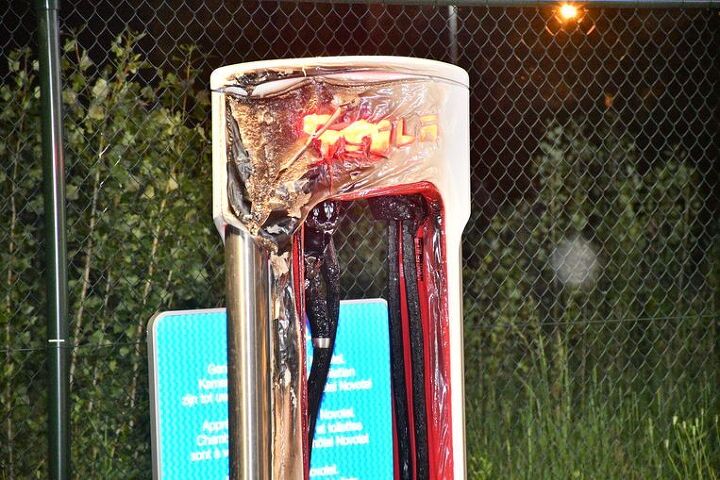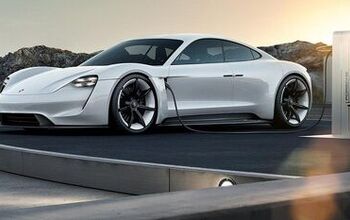New Tesla Fire Manifests in Belgium

A Tesla Model S suffered a total meltdown after being connected to one of the company’s proprietary Supercharger stations in Antwerp, Belgium. While details are scant, local reports state the driver simply went to charge his automobile and returned to a burning wreck a short time later.
Considering the fire department had to totally submerge the ruined vehicle in a pool of water to ensure the car didn’t reignite, the odds of uncovering exactly what went wrong appear slim. But it wasn’t all that long ago that Tesla was pushing over-the-air updates to mitigate a rash of fires that cropped up in the United States and Asia over the past few months. Surely, the manufacturer has some idea of what might have gone wrong.
“As we continue our investigation of the root cause … we are revising charge and thermal management settings on Model S and Model X vehicles via an over-the-air software update that will begin rolling out today, to help further protect the battery and improve battery longevity,” the company said last month.
Electrek, which translated the latest story from Het Laatste Nieuws, noted that the sudden increase in Tesla-associated fires represents a relatively small portion of the brand’s overall volume — adding that there have been many more fires related to gas-powered models over the last few months. Regardless of the ratio, lithium-ion battery vehicles present new challenges to fire departments as they require different tactics and ludicrous amounts of water. EV manufacturers also haven’t been terribly forthcoming about what causes battery fires, often because they don’t know the cause, either.
As a result, some companies are considering shifting toward nickel-metal hydride. However, while the newer materials are less susceptible to thermal runaway, they’re still being finagled for automotive applications and reactions are still possible and excessive heat can always ignite adjacent materials. Regardless of the components, overcharging a battery or overwhelming it with too high of a rate can still make it pop.
It’s unclear whether the Model S in Antwerp will help Tesla get closer to uncovering what’s causing the battery fires. The car was opened up for an investigation following a day-long bath on June 1st. The charging station, which melted during the blaze, will also be examined.
By our estimation, plus an investigation conducted by the NHTSA (with help from General Motors), lithium-ion battery systems seem to be about as safe to use as gas-powered cars in terms of overall fire risk. But a rash of well-publicized fires do nothing for the brand’s PR. As electric vehicles are still something of a novelty, every fire involving this type of vehicle is sure to garner media coverage. Not all will include contextual caveats to paint a broader picture. While not a death sentence in itself, Tesla’s run of bad press has done a number on its share price in 2019. For the company’s sake, one of the items on Tesla’s to-do list must be getting to the bottom of these fires.
[Images: HLN]

A staunch consumer advocate tracking industry trends and regulation. Before joining TTAC, Matt spent a decade working for marketing and research firms based in NYC. Clients included several of the world’s largest automakers, global tire brands, and aftermarket part suppliers. Dissatisfied with the corporate world and resentful of having to wear suits everyday, he pivoted to writing about cars. Since then, that man has become an ardent supporter of the right-to-repair movement, been interviewed on the auto industry by national radio broadcasts, driven more rental cars than anyone ever should, participated in amateur rallying events, and received the requisite minimum training as sanctioned by the SCCA. Handy with a wrench, Matt grew up surrounded by Detroit auto workers and managed to get a pizza delivery job before he was legally eligible. He later found himself driving box trucks through Manhattan, guaranteeing future sympathy for actual truckers. He continues to conduct research pertaining to the automotive sector as an independent contractor and has since moved back to his native Michigan, closer to where the cars are born. A contrarian, Matt claims to prefer understeer — stating that front and all-wheel drive vehicles cater best to his driving style.
More by Matt Posky
Latest Car Reviews
Read moreLatest Product Reviews
Read moreRecent Comments
- Lorenzo They won't be sold just in Beverly Hills - there's a Nieman-Marcus in nearly every big city. When they're finally junked, the transfer case will be first to be salvaged, since it'll be unused.
- Ltcmgm78 Just what we need to do: add more EVs that require a charging station! We own a Volt. We charge at home. We bought the Volt off-lease. We're retired and can do all our daily errands without burning any gasoline. For us this works, but we no longer have a work commute.
- Michael S6 Given the choice between the Hornet R/T and the Alfa, I'd pick an Uber.
- Michael S6 Nissan seems to be doing well at the low end of the market with their small cars and cuv. Competitiveness evaporates as you move up to larger size cars and suvs.
- Cprescott As long as they infest their products with CVT's, there is no reason to buy their products. Nissan's execution of CVT's is lackluster on a good day - not dependable and bad in experience of use. The brand has become like Mitsubishi - will sell to anyone with a pulse to get financed.



































Comments
Join the conversation
Yet another indication that Elon Musk is incompetent. Not only has he consistently failed to build competitive BEVs, as even after all this time they take forever to charge (it shouldn't take longer to charge a BEV than to fill a gas tank), but now the BEVs catch fire as well. Musk should give up making BEVs and stick to something he knows, like setting up tents.
Lowering it into a dumpster? Fitting, since Tesla is now a dumpster fire.